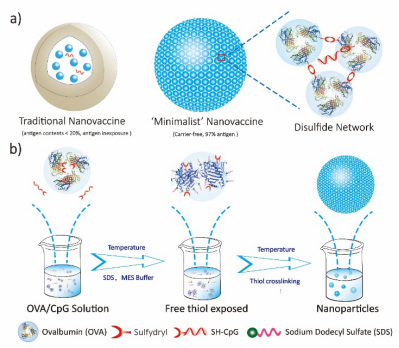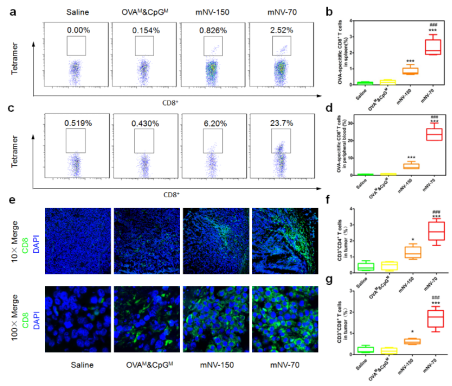Are immune checkpoints and CAR-T all the tumor
immunotherapy? It's way more than that. Vaccines are one of the possibilities. Vaccines
are not only recognized as the most contributory technology to human health in
immunoprevention but also highly expected in immunotherapy. Nowadays, vaccines are
in vigorous development, especially with the advent of high-throughput low-cost
antigen screening technology. The era of personalized vaccine is coming out
soon.
However, a vaccine is a duet of antigen and adjuvant.
Without adjuvant, the antigen alone could not do much single-handed. More than
90 years ago, it was the discovery of aluminum hydroxide adjuvant that laid a
technical foundation for the development of preventive vaccines. The antigen repository effect of aluminum hydroxide adjuvant
helped the vaccine to achieve great success in epidemic prevention.
The success of the aluminum hydroxide adjuvant could
hardly be replicated when the subject turns to cancer, which is more dependent
on cellular immunity. nanocarriers have both the characteristics of traditional
adjuvants and the size of viroids, and thus acclaimed as the hope of a new
generation of adjuvants. However, it is difficult for traditional nanocarriers
to give full play to the advantages of “viroid” immunity in vaccine design owing
to the difficulty of antigen surface exposure (being encapsulated) and low
antigen density (low loading rate), which greatly limits the improvement of
cellular immune effect.
In view of this, Yongyong Li’s research group of
Tongji University recently reported a new concept of minimalist nanovaccine on
ACS Nano, that is, to build a “self adjuvant” nano vaccine by excavating the packaging
potential of antigen, in which the antigen undertakes the dual functions of both
antigen and adjuvant, so as to overcome the two unavoidable problems of
traditional nano vaccine: difficulty of antigen surface exposure and low
antigen loading rate.
In this study, ovalbumin (OVA) was selected as the model
antigen. Through taking advantage of the unique chemical structure of proteins,
the researchers innovatively developed a new strategy of “regulating sulfhydryl
exposure + disulfide bond cross-link”. Without using any traditional
nanocarriers, more than 500 antigen molecules go “hand in hand” on the
nanoscale to form a stable disulfide bond spatial network structure, and thus construct
a new type of nano vaccine with “the most simplified” composition (nearly 100%
antigen). The whole method is fast, green, highly controllable in size, and has
good universality for other proteins.

Figure 1. Scheme for the structure and
assembly of OVA@CpG nanoparticles with 100% immune compositions.
It is encouraging that the new vaccine shows excellent
tumor prevention ability in the B16-OVA melanoma mice model. After three times
of preventive inoculation, no tumor was found in 7 of 10 mice attacked by B16-OVA,
and the tumor-free state lasted for the whole experimental period (18 weeks),
while all 10 mice in the control group developed tumor genesis and rapid growth.
In addition, this new vaccine can significantly prolong the survival period and
improve the survival rate of B16-OVA tumor-bearing mice. The mechanism study revealed
that the new vaccine could mediate a higher level of T cell immune effect and T
cell infiltration in the tumor area.

Figure 2.The tetramer assay of OVA-specific
CD8+ T cells, and tumor-infiltrating condition of T cells elicited by mNVs in
prophylactic test.
This work was recently published in ACS Nano (2018,
12, 6398-6409, DOI: 10.1021/acsno.8b00558, IF=13.7), titled as Minimalist
Nanovaccine Constituted from Near Whole Antigen for Cancer Immunotherapy.
Wang Kun, postgraduate of Tongji University, is the first author, and Prof。Li Yongyong is the corresponding author, while Tongji
University is the first signature unit. It is worth mentioning that the ACS
Nano editor introduced this work with the title of Less is More for
Cancer Nanovaccine (ACS Nano 2018, 12, 6347).
In addition, in 2018, Prof. Li Yongyong’s group also
developed a new physical regulation method for the important proposition “tumor
immunosuppression microenvironment”. Relevant results are published in the
famous journal Advanced Science (2018, 1700805, DOI: 10.1002 / advs.
2017008053, IF=12.4) under the title of Fever-Inspired Immunotherapy
Based on Photothermal CpG Nanotherapeutics: The Critical Role of Mild Heat in
Regulating Tumor Microenvironment. Based on the self-assembly of
disulfide bond in macromolecules, this work constructs a CPG photothermal
protein nanoparticles, which can form a “fever-like” microenvironment at the
tumor site as well as significantly improve the local immunosuppressive
microenvironment and immune effector cell infiltration of 4T1 tumor, and thus dramatically
improve the immunotherapeutic effect of CpG on in situ 4T1 tumor. The study discovered
that the induced immune memory effect caused by the CpG nanotherapeutics can
better control the tumor distant metastasis. Dr. Li Yan from Tongji University
is the first author, and Prof.Li Yongyong is the corresponding author, while
Tongji University is the first signature unit. Shortly after the publication,
the international journal Immunotherapy invited Prof. Xiaojun Xia from
Zhongshan University to make a special comment on this study (a CPG never for
cancer Nanovaccine, Immunotherapy 2018, 10, 631–633).
Reference:Mamo T,
Poland GA. Nanovaccinology: the next generation of vaccines meets 21st century
materials science and engineering. Vaccine 2012; 30: 6609–11.
